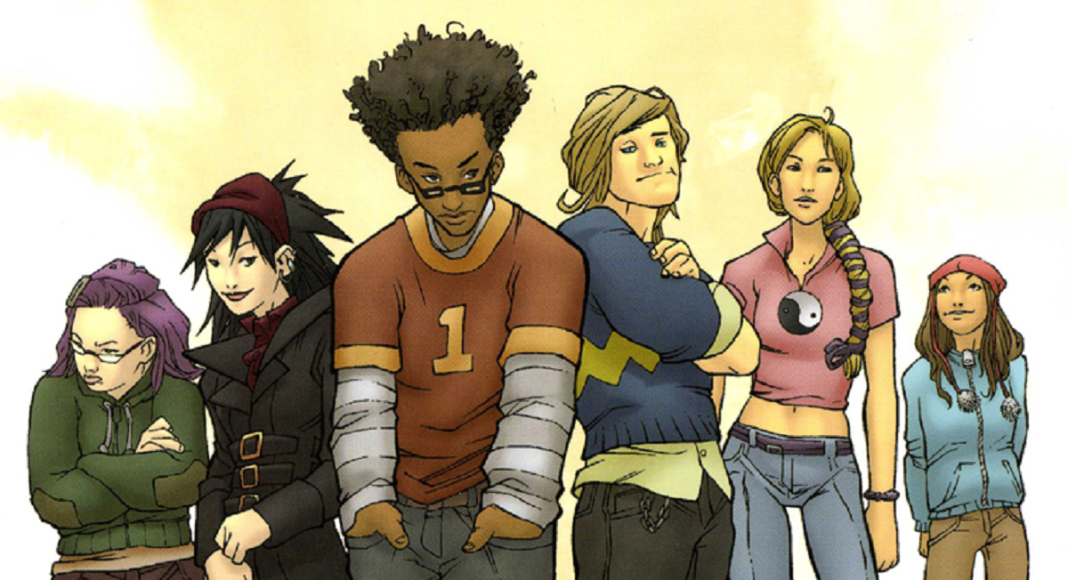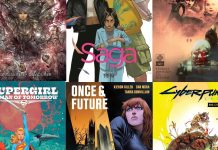Tsunami was a short-lived imprint for Marvel in 2003. It’s goal was more or less to bring a sort of manga sensibility to Marvel characters. How that was implemented across the line varied from book to book, but mainly it seemed to be in art style, even if mangaka weren’t tapped for the project.
It did manifest in theme in some of them, leading to a Namor romance book. The only one that really hooked me was Sentinel from Sean McKeever and the folks at UDON Studios, a boy and his robot tale. Most of the books only lasted a year, with the most popular being folded back into the main line. There was, however, a…runaway hit among the line, Runaways.
“And unlike your ‘internet friends’, those kids think of you as family. They can’t wait to see you!”
Runaways #1 by Brian K. Vaughan, Adrian Alphona, David Newbold, Brian Reber, and Paul Tutrone introduced us to six kids and their wacky parents with a dark secret. The premise itself is interesting, because it plays off of more of the teen drama in the beginning, with a twist and a hook that fits within the Marvel universe.
Because their parents are all super-villains.
I do feel like the high concept premises of many of Vaughan’s works function in his favour for whether or not people will initially check it out, though it raises the question of what other elements are there that make people stick around.
1. Controversy
There’s an ableist slur in the first issue of Y: The Last Man. It’s sadly not unique in Vaughan’s work, at least in the early half of the ’00s decade. That same slur appears in the first issues also of Swamp Thing, The Hood, Ex Machina, and here in Runaways. You could argue that it was a different time and that those kinds of slurs were more commonly acceptable. I think that’s nonsense. It may be called out more now, but we knew better then, too.
Hell, it’s even apparent in context of the first issue here that Vaughan knows better. Even if the dialogue pointing out that it’s wrong does so in a way that doubles down on that wrongness.
So why do it? A few different possibilities come to mind. Some could say that it’s to capture the vernacular of the time. To write dialogue like how many would have been speaking it. Especially kids. Some because they don’t know any better, others because they’re trying hard at edgy humour. Given that it’s not limited to kids in Vaughan’s work that kind of falls flat. It may be that it serves the same purpose that something like the kids’ parents reveal of villainy and murder. Shock. Getting people to talk about something controversial.
That kind of taboo can also easily get an adolescent to think they’re reading something that they shouldn’t. Granted, there’s also some casual sexism and use of gay as a pejorative, so you can take your pick of problematic parts of this issue.
2. Pop Culture
Runaways is arguably the Vaughan-penned work that is most like something written by Joss Whedon. To the point where Whedon even took over writing duties when Vaughan was finished. It’s present in the dialogue, how the characters interact with one another, the bits of sarcasm, the teen drama. And use of popular culture.
That can occasionally be a trap. Making works seem dated when they use pop culture references, but they can also better inform characters. At times making the audience relate to them more. Especially kids. Here we get an inventive use of an MMO that doubles as a reminder that this is set in the Marvel universe. And a kind of recommendation that everyone should watch the originals of The Prisoner.
“No…they’re super heroes.”
I actually wasn’t initially a fan. Adrian Alphona’s art at the time wasn’t for me. Somewhat strange since it was his work in the second volume of the series that eventually drew me in. At the beginning, it was big mouths and weird angles, keeping me at a distance. It reminds me a bit of the work of Akira Toriyama, taken to a different level of exaggeration and not as cartoon-like, but I feel there’s a different influence that I’m missing. Though I do understand how it would appeal to many. There’s a verve to his work here that captures the youthful energy of the story and I can see how it would also appeal to people looking for Tsunami’s manga-inspired flavour.
The art overall, especially Brian Reber’s beautiful colours, give a youthful vibe to the story. Paul Tutrone also uses a mixed-case font here, giving it a different feel from the traditional all caps. Marvel had started doing that to differentiate the Ultimate line, so it’s interesting to see here as well.
Runaways #1 from Vaughan, Alphona, Newbold, Reber, and Tutrone added something new and lasting to the Marvel Universe, subtly building on the legacy of multiple disparate aspects. All of it tied up in an interesting teen drama.
Classic Comic Compendium: Runaways #1
Runaways #1 – “Pride and Joy – Chapter One”
Writer: Brian K. Vaughan
Penciller: Adrian Alphona
Inker: David Newbold
Colourist: Brian Reber
Letterer: Paul Tutrone
Publisher: Marvel Comics / Tsunami
Release Date: April 16 2003
Available collected in Runaways: Pride and Joy, Runaways: Complete Collection – Volume 1, and Runaways by Brian K. Vaughan and Adrian Alphona Omnibus
Read past entries in the Classic Comic Compendium!







